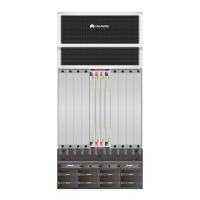Before the board is powered on and registers, this indicator status
changes in the following sequence: off > blinks quickly > steady
on > blinks quickly > steady on > blinks slowly (0.5 Hz).
After the board is powered on and registers, if this indicator blinks at
0.5 Hz, the system is working properly.
If this indicator is steady on, an alarm is generated.
If this indicator is off, no alarm is generated.
If this indicator is steady on, the board functions as the master one.
If this indicator is off, the board functions as the slave one.
If this indicator is steady on, the link is Up.
If this indicator is off, the link is Down.
If this indicator is blinking, data is being transmitted and received.
If this indicator is off, no data is being transmitted or received.
Table 1-136 Management interfaces
Ethernet
interface
(10M/100
M/1000
M
Base-TX
autonegot
iation)
It connects to
an NMS and
can work in
half-duplex or
full-duplex
mode.
Super category 5 shielded twisted
pair
It connects to
the console for
on-site system
configuration.
Baud rate: 9600
bit/s (default
value), which is
configurable.
It connects to
the modem for
remote
mainteN/Ance
by means of
dial-up. Baud
rate: 9600 bit/s

